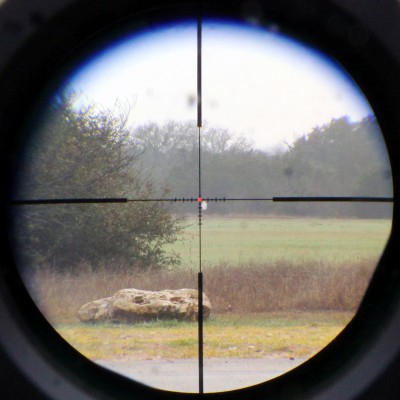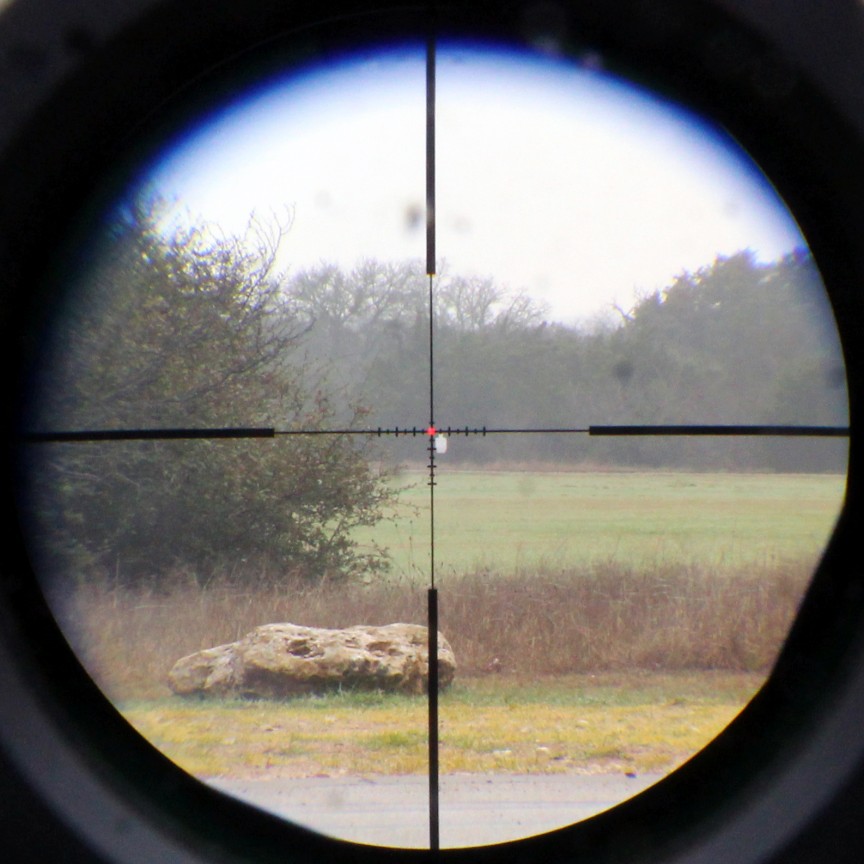
SR4C mounted on Larue PredatAR 5.56 for long distance evaluation. Using the MIL scale reticle with both windage and elevation substensions, the SR4C provided faster hits from 300-500 yards than the ACOG TA31F.

Reticle view on 4x at 400 yards against a full size IPSC target. Using a 100 yard zero, 1.5 MILs of elevation and 1 MIL of windage due to cross wind were required to make hits.
Eager to test out the MIL scale reticle, I mounted the SR4C on a 16 inch Larue PredatAR 5.56 using a Larue Tactical 30mm mount, zeroed the cross hair at 100 yards, and setup a course of fire using two 4 MOA targets each at 300, 400, and 500 yards and pitted it against the staple of rugged military 4x optics: the Trijicon TA31F ACOG. While the ACOG has an etched bullet drop compensator (BDC) from 100 to 800 yards, it is calibrated for a specific bullet traveling at a specific muzzle velocity. The SR4C’s MIL scale reticle allows more load flexibility, but it requires the shooter to remember the specific holdovers. Using a 100 yard zero, I found that I needed to holdover .5 MIL at 300 yards, 1.5 MIL at 400 yards, and 2.5 MIL at 500 yards. Numbers can be typed into ballistic calculators all day, but in the end hits matter. These holdovers are what got hits. Surprisingly the accuracy of the ACOG’s BDC fell off after 400 yards using 55 grain ammunition, and I had to hold halfway between the 400 and 500 yard marks to get hits at 500 yards. Once dope was confirmed, other officers and I took turns engaging all six targets for time. The SR4C’s horizontal MIL marks came in handy since 1 MIL of windage hold was required at the further distances. Since we were holding off for windage and elevation, the thick reticle lines were not a problem and did not obscure the targets at all. I managed a clean run, hits on all six targets in six rounds, in 22 seconds. While the ACOG’s marked BDC with thinner lines offers a cleaner sight picture and quicker holdovers, the combination of incorrect BDC calibration and no windage reference gave us a best time of all six hits in 29 seconds with no clean runs. The SR4C certainly had no trouble holding its own against the industry leader in medium range combat optics.
Next up – Part 4: Close Range Evaluation


Comments
Isn’t the ACOG’s BDC in meters not yards? Why is the author calling the calibration “incorrect” Also the bullet weight is for 62gr M855 rather than 55gr. I’m using a 16 inch barrel along with 62gr PMC and the holdover marks on my TA31F work precisely beyond 400 meters every time.
Thank you Pete for the comment, and I hope you found our review useful. The ACOG TA31F BDC is calibrated in meters for 62gr M855 traveling 2970 feet per second with a ballistic coefficient of .304 out of a 14.5″ barrel in a specific atmospheric condition with a height over bore of 2.5″. The BDC will be incorrect to varying degrees if any of these factors are different. During this evaluation, we were shooting 55gr grain ammunition out of a 16″ barrel in likely a less dense atmosphere than the BDC is calibrated for. Add in that the measurements we had were in yards instead of meters, and the combination of factors different than the BDC calibrations added up to some incorrect drop information around the 400-500 yard distances. We were able to establish that and correct for it very early in the testing, so I think the performance difference was not a result of the targets not lining up perfectly with the BDC marks. Instead, I believe it was due to the wind. The ACOG BDC marks are different sizes to correspond to the thickness of a human silhouette at their respective distance to assist in ranging. This inconsistency made “holding off in space” to correct for wind a little trickier on the eye with the ACOG BDC than the more consistent marks on the SR4C’s MIL reticle. Obviously, this did not make hits with the ACOG impossible just about 30% slower under these conditions. The ACOG is an excellent optic with a very useful and easy to use reticle. However, the SR4C’s MIL reticle can be a little more flexible for different conditions if the shooter is willing to memorize more complex holdovers. Everything is a trade off.
I will note that if you convert the distance measurements from yards to meters then the BDC information in the ACOG was still very close to correct. Perhaps “incorrect” was the wrong word to use. Instead, I would say that the BDC was not optimal for the shooting conditions during that test. However, targets are rarely spaced perfectly at 100 meter intervals, so I think the ACOG BDC’s trade off in wind compensation for an easier to use reticle were well demonstrated by our test. Thanks again for reading our review, and let us know if you have anymore questions.